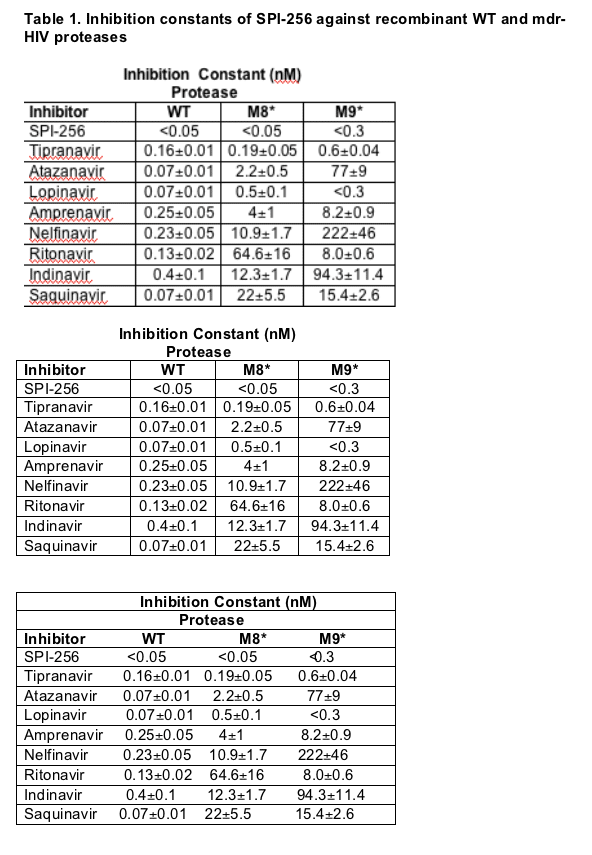 |
 |
 |
| |
SPI-256, a Highly Potent HIV Protease Inhibitor with Broad Activity Against MDR
|
| |
| |
Reported by jules Levin
13th CROI (Retrovirus Conference) Denver, Feb 5-8, 2006
SV Gulnik, El Afonina, M Eissenstat, Neil Parkin, Anthony Japour, and JW Erickson
Sequoia Pharmaceuticals Inc, Gaithersburg, Maryland, USA, Monogram Biosciences, Inc, san Francisco, California, USA
Researchers from little known Sequoia presented promising & interesting preclinical data for this new protease inhibitor.
The author's conclusions:
- SPI-256 has subnanomolar potency against WT B & non-B HIV strains in Monogram Biosciences PhenoSense HIV assay and is 4-50 fold more potent than currently approved PIs.
- SPI-256 remains fully active against mutants with single primary mutation (groups 8-12) and viruses resistant to a majority of reference PIs (groups 4 & 5).
- Resistance to SPI-256 requires accumulation of multiple primary protease mutations (groups 6, 7). Importantly SPI-256 remains highly potent even against these viruses with average IC50 12.9 nM.
- SPI-256 represents a potent new generation antiviral agent for first-line and salvage therapy.
Summary of Antiviral Activity and Phenotypic Resistance Data
- SPI-256 is 4-50 fold more potent than reference PIs against WT B & non-B clades: mean IC50 = 0.3 nM (range: 0.2 - 0.4 nM).
- SPI-256 is fully active against viruses that are highly resistant to the majority of reference PIs (groups 4 and 5): mean IC50 = 0.5 nM (range: 0.2 - 0.9 nM).
- SPI-256 retains high potency against worst-case MDR viruses (groups 6 & 7), although efficacy is reduced compared to WT: mean IC50 = 12.9 nM (range: 1.8 - 34 nM).
- SPI-256, like reference PIs, is hypersensitive to the Atazanavir I50L mutation (group 3): mean IC50 <0.1 nM).
- SPI-256, unlike reference PIs, retains wild type potency against viruses that harbor primary mutations in addition to the I50L mutation (group 14): mean IC50 0.2 nM (range: 0.2 - 0.3 nM).
- SPI-256 remains fully active against the NFV mutations, D30N/N88D, that confer cross-resistance to most or all other PIs (group 1): IC50 = 0.2 nM.
- Viruses with any of the single primary mutations V82A, F, T; L90M, I84V and N88S remain fully sensitive to SPI-256 (groups 8-12). Viruses with an I50V mutation (group 2) show reduced relative, but high absolute sensitivity to SPI-256 to SPI-256: IC50 <5.0 nM.
According to recent estimates over 75% of drug-experienced patients in North America harbor HIV that is resistant to one or more of the antiretroviral agents used in multi-drug 'cocktails'. Moreover, it has been estimated that drug-resistant HIV accounts for up to 12% of new infections The number of reported cases of patients infected with MDR-HIV is rising steadily. Mutations within the protease gene that confer clinical drug resistance have emerged for all the FDA-approved HIV protease inhibitors (PR). The particular sequence and pattern of mutations selected by PIs is believed to be somewhat drug-specific and often patient-specific, but high level resistance is typified by multiple mutations in the protease gene which give rise to cross-resistance to all of the PIs.
Sequoia has implemented a structure-based approach for the design of novel HIV protease inhibitors (PIs) with high potency against WT and MDR viruses. In this approach the conserved atomic interactions were identified among the structurally different PIs and WT and drug-resistant HIV PRs. Series of inhibitors that preferentially interact with the constellation of conserved atoms within the active site were designed and synthesized.
Inhibitors were first presecreened in the enzyme-based assay using WT and selected MDR PRs. Promising leads were then profiled in 5 days cell-based antiviral assay using in-house panel of clinically derived MDR viruses that resulted in several pre-clinical candidates.

*M8 and M9 were derived from patientisolates and have mutations at the following positions: M8: 10, 11, 22, 24, 35, 36, 37, 41, 43, 54, 62, 63, 71, 84,
M9: 10, 13, 32, 37, 46, 63, 71, 84, 89,, and 91.
The Monogram Biosciences panel included viruses with HIV PR derived from several non-B strains of different tropism as well as different PI resistant mutants derived from patients' isolates that contain up to 21 total substitutions in the PR gene. For the purpose of data analysis PI resistant mutants were divided into following categories:
- Viruses containing one primary PI mutation: groups 1, 2, 8-12
- Viruses with I50L or I50L with other primary mutations: groups 3 and 14
- Viruses with V32I and !47V: group 13
- Viruses highly resistant to LPV (FC>30) and 3 other PIs (FC>10): group 4
- Viruses highly resistant to IDV (FC>30) and 4 other PIs (FC>10): group 5
- Viruses highly resistant to all PIs (FC>50) or containing 6 primary PI
mutations: groups 6 & 7
The table displayed was very large, but SPI-256 was more potent than every other PI against each group.

|
|
| |
| |
|
 |
 |
|
|